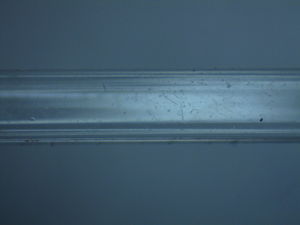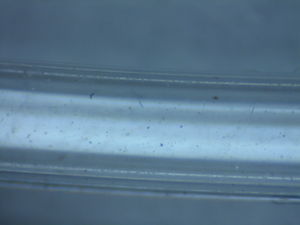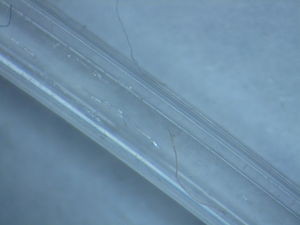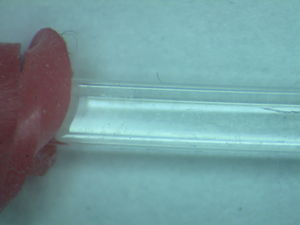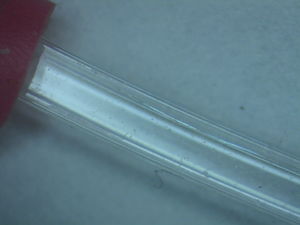Difference between revisions of "Microscope Images"
(jpg uploads/links to wiki commons) |
(→Used Fibers: image annotation and placement.) |
||
| (One intermediate revision by the same user not shown) | |||
| Line 1: | Line 1: | ||
| − | + | =Fiber Images in Natural Light Under Microscope= | |
| + | ==Used Fibers== | ||
| + | Presented below are images of a fiber segment that had been processed and bent according to procedures discontinued or updated by January 2015. These procedures included cleaning with solvents, temporarily bundling with velcro straps, labeling with sticky tags, and straightening and bending with heat and hot water. Additionally, these fibers may have been exposed to glue and/or paint. In the time between their handling and these images, they were handled as scraps; therefore, it is hard, if not impossible, to attribute their damage to previous handling procedures. However, examining their scratches and markings provides insight into their susceptibility to damage. | ||
| − | |||
| − | |||
| − | [[File:1greendirty | + | Figure 1 exhibits dust from the environment and rubber from the researcher's gloves. There appears to be a slight film over the waveguide, which might be from a combination of normal dust and humidity. Additionally, there appears to be embedded debris creating a pock-effect on the lelft-hand side of the fiber. |
| + | [[File:1greendirty 03.JPG|thumb|Figure 1: Dust and dirt appearing on clear waveguide. (MFR Saint Gobain BCF-98).]] | ||
| − | |||
| − | [[File: | + | Figure 2 shows more rubber threads and a dirty film over the fiber. It is clear that if we cannot avoid exposing the fibers to air, we need a cleaning procedure that does not damage the guides or leave its own film. The optical effects of dust on fibers is demonstrated in the laser photography section. |
| + | [[File:1greendirty 06.JPG|thumb|left| Figure 2: Dust and dirt appearing on clear waveguide. (MFR Saint Gobain BCF-98).]] | ||
| − | [[File:1pinkdirty 09.JPG|thumb|Dust and residue appearing on clear waveguide. (MFR Saint Gobain BCF-98).]] | + | |
| + | On Figure 3 (below) we see stray particles that look like threads. More importantly, we notice lengthwise gouges that the researcher does not attribute to everyday handling. The researcher wonders whether these gouges are the result of the previous bending procedure which occurred with heated fibers in room-temperature air. | ||
| + | [[File:1greendirty 08.JPG|thumb|center|Figure 3: Lengthwise cracking and fibers appearing on clear waveguide. (MFR Saint Gobain BCF-98).]] | ||
| + | |||
| + | |||
| + | |||
| + | Figures 4 and 5 are the same segment of fiber but with different features in focus. In Figure 4, we see surface scratches most clearly along the lower left-hand side of the wave guide. These scratches do not have a dominant orientation and seem to be of various lengths and a range of shallow depths. The researcher suspects damage like this is due to hook-and-loop binding, clamping, and other procedures which could introduce randomly-oriented damage. | ||
| + | [[File:1pinkdirty 07.JPG|thumb|left|Figure 4: Dust and residue appearing on clear waveguide. (MFR Saint Gobain BCF-98).]] | ||
| + | |||
| + | |||
| + | Figure 5 also shows some of the same weathering as Figure 4, however, one can also observe damage along the top and bottom edges of the square waveguide. The researcher examined these fibers closely and noted no visible change to their geometry. That is, while these depressed ridges appear to be along the edges of the wave guide, they must be internal rather than external. Large light loss is visible along the edges of these old fibers when examined with lasers. | ||
| + | [[File:1pinkdirty 09.JPG|thumb|center|Figure 5: Dust and residue appearing on clear waveguide. (MFR Saint Gobain BCF-98).]] | ||
Latest revision as of 01:14, 28 December 2015
Fiber Images in Natural Light Under Microscope
Used Fibers
Presented below are images of a fiber segment that had been processed and bent according to procedures discontinued or updated by January 2015. These procedures included cleaning with solvents, temporarily bundling with velcro straps, labeling with sticky tags, and straightening and bending with heat and hot water. Additionally, these fibers may have been exposed to glue and/or paint. In the time between their handling and these images, they were handled as scraps; therefore, it is hard, if not impossible, to attribute their damage to previous handling procedures. However, examining their scratches and markings provides insight into their susceptibility to damage.
Figure 1 exhibits dust from the environment and rubber from the researcher's gloves. There appears to be a slight film over the waveguide, which might be from a combination of normal dust and humidity. Additionally, there appears to be embedded debris creating a pock-effect on the lelft-hand side of the fiber.
Figure 2 shows more rubber threads and a dirty film over the fiber. It is clear that if we cannot avoid exposing the fibers to air, we need a cleaning procedure that does not damage the guides or leave its own film. The optical effects of dust on fibers is demonstrated in the laser photography section.
On Figure 3 (below) we see stray particles that look like threads. More importantly, we notice lengthwise gouges that the researcher does not attribute to everyday handling. The researcher wonders whether these gouges are the result of the previous bending procedure which occurred with heated fibers in room-temperature air.
Figures 4 and 5 are the same segment of fiber but with different features in focus. In Figure 4, we see surface scratches most clearly along the lower left-hand side of the wave guide. These scratches do not have a dominant orientation and seem to be of various lengths and a range of shallow depths. The researcher suspects damage like this is due to hook-and-loop binding, clamping, and other procedures which could introduce randomly-oriented damage.
Figure 5 also shows some of the same weathering as Figure 4, however, one can also observe damage along the top and bottom edges of the square waveguide. The researcher examined these fibers closely and noted no visible change to their geometry. That is, while these depressed ridges appear to be along the edges of the wave guide, they must be internal rather than external. Large light loss is visible along the edges of these old fibers when examined with lasers.
